

2022-03-28 12:00:00 AM | 1744 ![]() Print
Print ![]() PDF
PDF
Universal Analytics will no longer process new data in standard properties beginning July 1, 2023. Prepare now by setting up and switching over to a Google Analytics 4 property.
This is the GOOGLE ANALYTICS 4 release date which is shown on all Universal Analytics user dashboards, and in this tutorial, I will be comparing Google analytics 4 reports vs Universal analytics and how to use Google Analytics 4 For Beginners.
Google web analytics is a certified household name among web-masters that are looking at getting data information on their website performance, with over 20 million users, according to BuiltWith, 29 million sites—including 87 percent of the most popular 10,000—were using the tool as of May 6, 2021. Also, there are Google Analytics individual qualifications you can earn via Google Analytics courses and training, you get Google Analytics certification via Google analytic academy.

Google Analytics 4 Reports (GA4) Image courtesy: Google.
Google Analytics, or GA, is an analytics web tracking tool that provides web-masters a full in-depth report on their website/app performance It integrates with other Google's marketing and advertising platforms and products (including Google Ads, Search Console, and Data Studio) this makes it a popular choice among web-masters that utilize multiple Google tools.
Now Google Analytics 4 is the new development of the current Universal Analytics which was introduced in 2014 to replace the then Google analytics which was more of a visualization log of data representing website traffic as this period Google were not in the business of commercializing data, as technology evolved and the way data were perceived and collated changed, hence the need to adapt and Universal Analytics became the new standard as the diversity in user devices expanded.
The GA4 is an improved version of Universal analytics as it introduces machine learning and predictive features to the way users analyze web/app data performance, unlike before where data was built around users and events – not sessions, as we’ve been used to.
With GA4 an events-based model processes each user interaction as a standalone event, this can be seen from the comparison of GOOGLE ANALYTICS 4 vs UNIVERSAL ANALYTICS real-time visit counts.
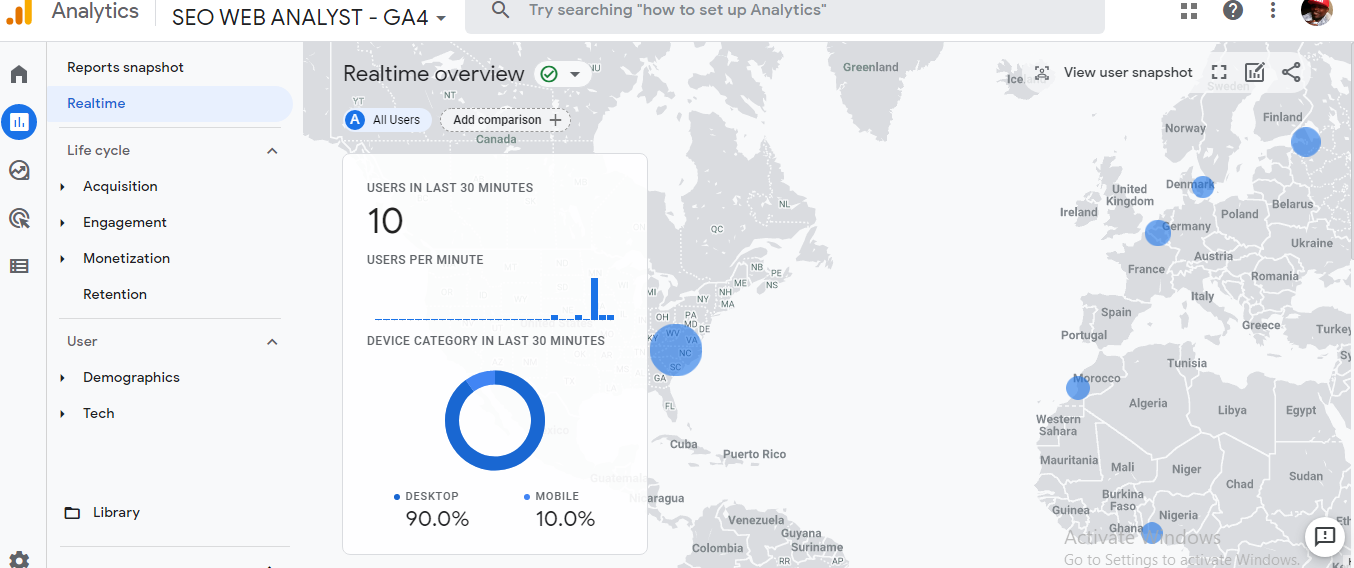
GA4 real-time visit Reports.

Universal Analytics real-time visit Reports.
From the images above comparing the two web traffic analytics, we can see that Universal had more traffic count and this is because of the way data are being passed and analyzed on Google Analytics 4, as it counts visits per minute, this iteration of Google Analytics is quite new and you need to set it up to collate data as data from the Universal Analytics are not being imported, this is why Google encourages setting up GA4 as soon as possible as GA4 does not bring retrospective data from Universal Analytics into GA4.
Step 1.) Click on the "Let's Go" button on the right corner of your message box

Step 2.) Follow the prompt that takes you to the admin set up page where you are to set up a new GA4 property for your website.
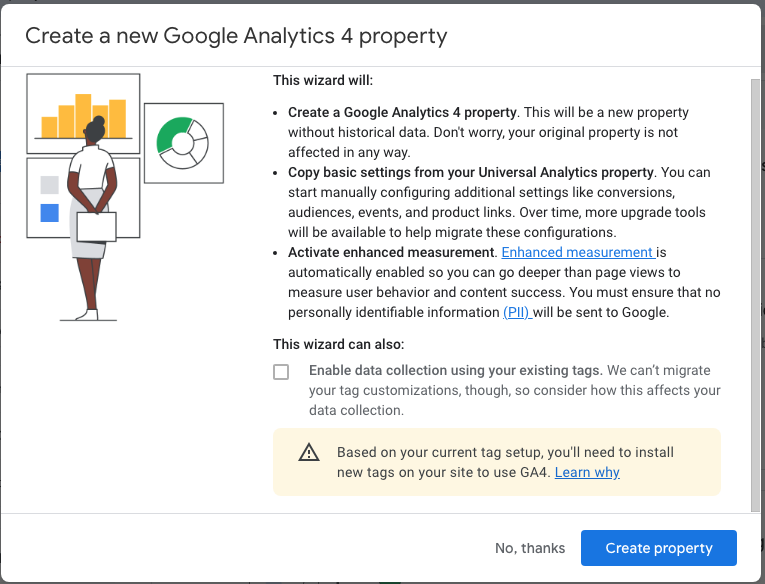
if you notice in the prompt window in your Google Analytics 4 set up, that you have a based warning like the one described above it only means you are not using a compatible Google analytic tag, this does not stop you from creating the Google Analytic 4 property for your website, so click on the create property.

Step 3.) As soon as you click on the create property you will be shown another window similar to this image, you should notice the "Not Connected" beside the Google Analytics 4 Property Setup, this means we are not done yet. You should click on the "Get Started" button so that you can continue to the next prompt page...if your Google Analytic tag is compatible (if you didnot see the based warning message) the wizard check box will be checked for you and the wizard will do the configuration for you automatically.
step 4.) When "Get Started" has been clicked on you should get a new home page like the one below and quickly start seeing your traffic visits in real time reports displaying on your dashboard.

At this point there is no more configuration required from you, simply wait while the AI does is job for the next 7 days, for your data to become quantifiable you will need to wait 28 days to start utilizng the other tools on the dashboard.
Step 5.) Now if your landing page does not look like the one above with the analytics reading your website traffic in real time reporting, then you need to still connect the Google Analytic 4 property to your website via adding the code given to you...something like this "G-20RZSVQZDG" you need to click on the tag instruction button.

There are two instances on the next prompt page, the first tab explains adding your tag as a new code, meaning you have never used Google analytics before and this is your first time instance, and also if you are using a self host website e.g hosted WordPress site or blogger. Using the Global site tag (gtag.js) helps in resolving all the friction.
The next option is the implementation of Google tag manager which is like a container tool box where all your tags can be managed in one single tag code (we recommend this as we use this method ourselves), you shall see in the next tutorial how to get your Google tag manager integration working with your analytics.
Step 6.) We are going to be working with the second tab "use-exiting on pag tag", since we already have a working tag on our website, so all we need to do is to add the GA4 tag code into the tag manager.
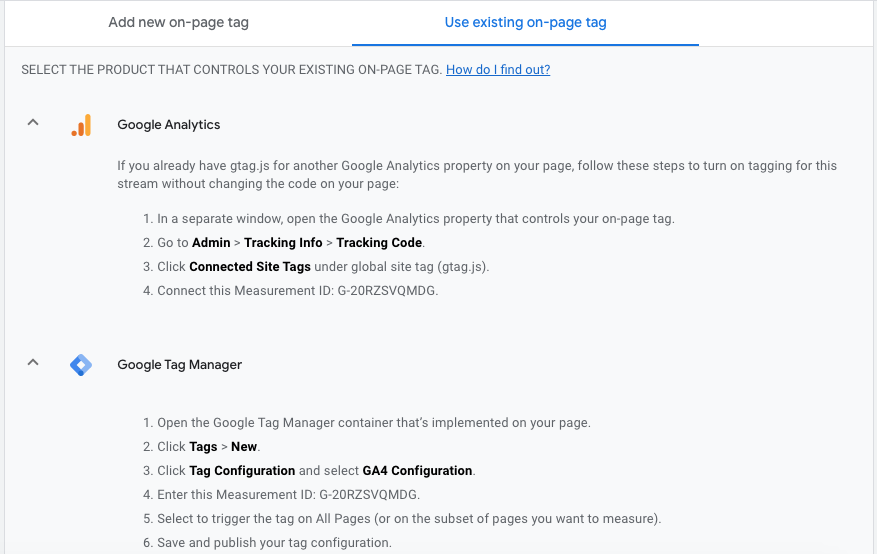
Now like have said before, if you already have a Google global tag on your website you don't need to worry as all you need to do is to simply connect to it by following the example in the prompt.
While for the Google tag manager all you need to do is to follow the prompt instructions, if you don't have a google tag manager I suggest you work with what works for you.

Step 7.) Click on your website container from the Google Tag manager home page, on the dashboard click on the NEW TAG, you can now follow the instructions as explained on the message prompt in step 6. After you must have setup as instructed in the prompt message you should now have a dashboard with a Google Analytics 4 Property Setup showing "Connected". You can read more details on setting up Google Analytics 4 from Google analytics 4 for beginners.
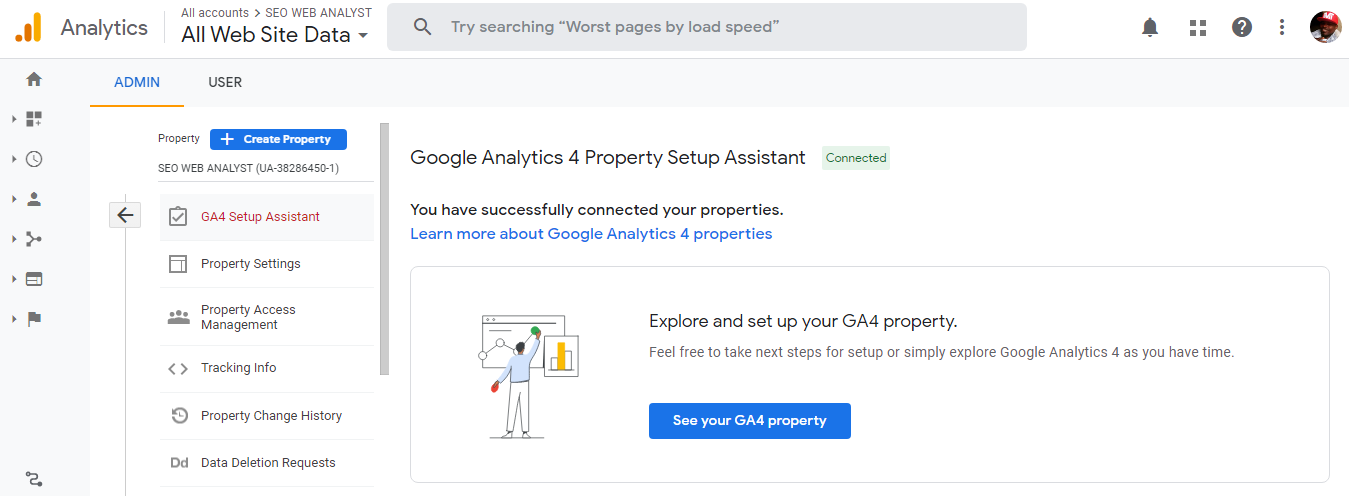
Ok so now we have reached our most cogent section of our post, the GA4 analytic report is totally based on machine learning and it is much more in-tune in measuring your website success by providing data-driven insights to improve your marketing decisions for a better ROI.
By applying Google’s advanced machine learning models, the new Analytics can automatically alert you to significant trends in your data - like products seeing rising demand because of new customer needs. It even helps you anticipate future actions your customers may take. For example, it calculates churn probability so you can more efficiently invest in retaining customers at a time when marketing budgets are under pressure. We’re continuing to add new predictive metrics, like the potential revenue you could earn from a particular group of customers. This allows you to create audiences to reach higher value customers and run analyses to better understand why some customers are likely to spend more than others, so you can take action to improve your results...quoted from
Vidhya Srinivasan
VP/GM Buying, Analytics and Measurement, Google Ads

An example of predictive metrics in Google Analytics 4. Image: Google.
This technology is also used to predict outcomes, such as churn rates and the potential revenue a business could earn from a particular segment of customers. Those insights can help marketers anticipate actions their customers might take in the future and focus on higher-value audiences.
The platform is engineered for most e-commerce or websites that are using their platforms for other online earning means, we are now in an AI driven technology era and most application are driven by AI and maching learning, so it is not a surprise that web analytics report system should follow suite.
Unlike the Universal analytics the Google analytics 4 offers Deeper audiences integration with Google Ads. Future wise, Google will further rely on machine learning development to rely on filling the gap in data sparsity.
Another thing that makes the new GA4 much better than Universal analytics report is the ability to delete data based on request, making it easy to follow up on GDPR policies.
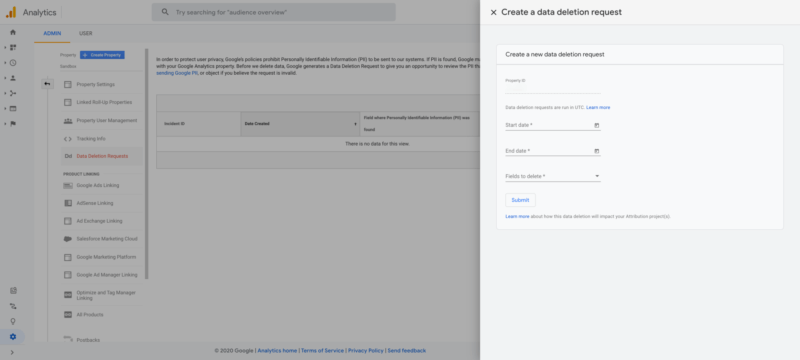
The new Google Analytics is now the default experience for new properties and is where Google is investing in future improvements. They are aware that there are other features other marketers require prior migrating fully from Universal Analytics setup, so they recommend you create a new Google Analytics 4 property (previously called an App + Web property) alongside your existing properties. This will allow you to start gathering data and benefit from the latest innovations as they become available while keeping your current implementation intact. If you’re an enterprise marketer, Google is currently in beta testing with Analytics 360 version that offers SLAs and advanced integrations with tools like BigQuery, plus more features rolling out.

I am a seo web analyst and have a love for anything online marketing. Have been able to perform researches using the built up internet marketing tool; seo web analyst as a case study and will be using the web marketing tool (platform).
How To Fix Cloudflare Error 522 Connection Timed Out
How To Optimize Cache Performance via HTACCESS Apache Server
How To Fix GA4 Showing Wrong Domain Traffic
How To Reactivate Google Adsense Account
How Do You Write Pitch Deck That Wins Investors
Effective Lead Magnet Funnel Examples For Businesses
How To Promote FMCG Products Using Digital Marketing
The Main Objectives Of SEO in Digital Marketing
How Artificial Intelligence Is Transforming Digital Marketing
Google CEO Sundar Pichai: Search will profoundly change in 2025